Gift Card Balance
Enter the code below to redeem your gift card

The Golden Pothos (Epipremnum Aureus), a gorgeous plant with heart-shaped leaves, is an excellent choice for indoor spaces. It's an air-purifying plant that removes toxins from the air. But you may have heard that the Golden Pothos is toxic to cats, dogs, and people.
So, although popular for its many benefits, the Golden Pothos plant isn't ideal for homes with pets and young kids. It contains toxic substances that can cause mild to severe reactions in pets and children if ingested. No wonder it’s sometimes referred to as the Devil's Ivy!
Let's learn a little more about this beautiful trailing vine.
The golden pothos contains a biomineral called calcium oxalate in crystal form, which is toxic. These crystals are tiny and needle-like and can cause adverse side effects if pets and children chew or ingest part of the leaves and stems of the plant. The same is true for other pothos varieties, such as the Pothos Pearl Jade, Marble Queen Pothos, Silver Splash Pothos, and more.
The intensity of the toxicity may vary with these species. But they all cause some level of oral and gastrointestinal issues like irritation, swelling, vomiting, as well as difficulty in swallowing.
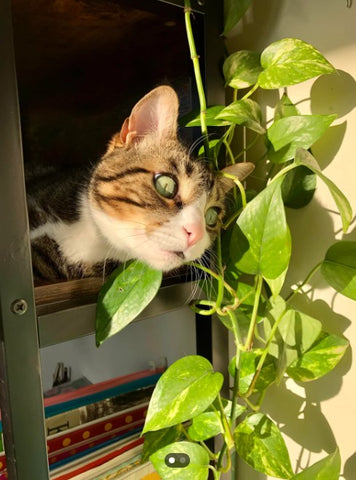
The needle-like calcium oxalate crystals in golden pothos are toxic to cats. Although moderately harmful, the symptoms from ingesting the plant (even in small quantities) can be quite uncomfortable, causing a stinging sensation in your kitty's mouth, drooling, vomiting, and an upset stomach.
But is the golden pothos poisonous to cats in a lethal way? In rare but severe cases, it can affect your cat’s kidneys, heart, and lungs and cause death. This is especially true if the cat is too young or old or has it has kidney problems or other health issues.
If your cat eats a golden pothos, it will display the following symptoms quite quickly:
The side effects of chewing a golden pothos show immediately after a cat eats any plant parts. Take your cat to a vet straight away or contact Pet Poison Control.
The toxic crystals can adversely affect your cat’s kidneys, heart, or lungs if no immediate action is taken. They can cause renal failure or cardiopulmonary issues within 12-48 hours, leading to death.

The non-soluble, needle-shaped calcium oxalate crystals in golden pothos make it toxic for dogs, as well. The poisonous Devil’s ivy can irritate your canine companion’s throat and stomach if ingested. Your dog may experience pain, inflammation, possible airway obstruction, irregular heartbeat and difficulty in breathing.
Is golden pothos poisonous to dogs if consumed in large quantities? It can cause renal or cardiopulmonary problems in your dog that can sometimes prove fatal. But, such incidents are rare and usually occur only if the dog is aged or ailing.
If your dog eats part of the leaves or stems of a golden pothos, you’ll see the following symptoms:
Symptoms may appear as early as within a few minutes of your dog eating a golden pothos plant. So, you should immediately visit a local vet or contact Pet Poison Control. As a first-aid action, consider rinsing your dog’s mouth and giving your pet plenty of water.
The same toxic substance in the leaves and stems of the Devil's Ivy can cause irritation to your skin. This makes it poisonous to humans, especially children. So, it's vital to keep curious toddlers away from this plant. Luckily, the golden pothos is not as dangerous to humans as it is to pets due to the lesser chance of being ingested in large quantities. The initial painful sensation often discourages young toddlers or babies from consuming too much of the plant, which can become deadly.
The Devil’s ivy can be poisonous to touch, especially if the leaves or stems are squeezed. The needle-like crystals cause skin irritation. So be careful when handling the plant. Since toddlers and babies tend to grab things with a tight grip, their soft skin is more likely to get affected if they come in contact with this indoor plant.
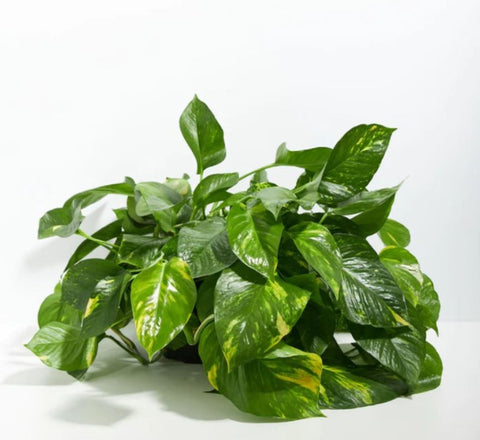
The golden pothos can cause mild discomfort or severe reactions if ingested by pets and kids. So, you should follow a few simple steps to make the golden pothos safe for cats, dogs, and young children. Start by keeping it out of your kids and pets’ reach. Place it on a high shelf or in a green house that cannot be accessed easily by your beloved cat or dog.
Also, as a precaution, always wear gloves while handling your Devil’s ivy during pruning and cleaning sessions or when you’re repotting the plant. Remember to wash your hands afterward.
Cats are curious, agile housemates. It’s impossible to train them to do certain things. So, to keep your cat away from the toxic plant, follow these tips:
Dogs might love snacking on plants, but they are easier to train. They also don’t tend to jump onto high spots. Here are the things you can do to protect your dog from the toxic effects of a golden pothos:
Since the Devil’s Ivy is toxic to cats, dogs, and humans, not growing it in your home is the safest thing to do. But don’t worry! Having pets and kids at home doesn’t mean you can’t have an indoor green corner.
You just need to find a few pet-safe plant alternatives, like the following:
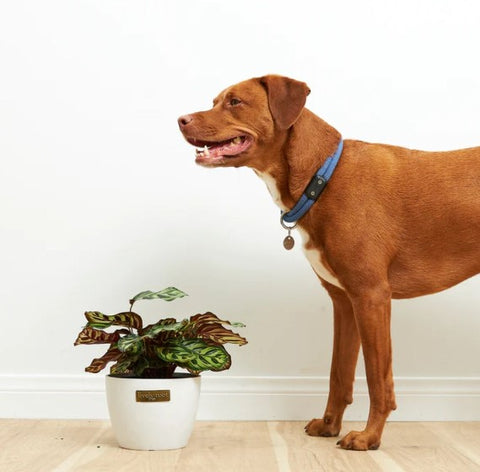
The Peacock Plant (Calathea Roseopicta) is the perfect choice if you love plants with vibrant leaves. Its foliage flaunts a combination of dark red, green, and yellow. Interestingly, the leaves rise and go down throughout the day as if they were praying. This gorgeous prayer plant is completely pet-safe.
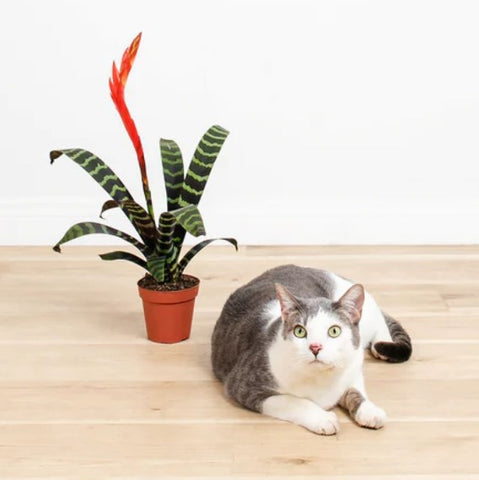
The Flaming Sword Bromeliad (Vriesea Splendens) could be the perfect pet-safe, tropical accent piece in your room. You’ll love its unique sword-shaped flower in a flaming red color. It offers a sharp contrast against the dark green leaves with black and purple stripes.
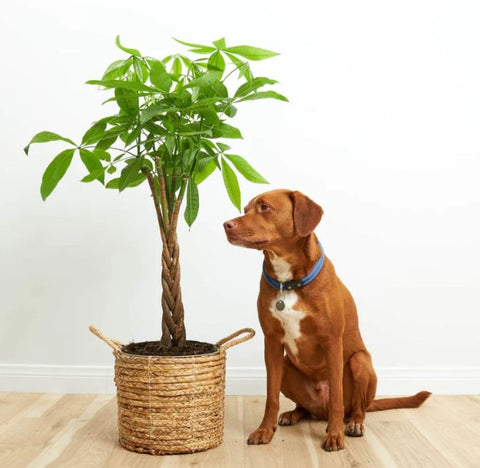
Another popular and easy-care houseplant that’s perfectly safe for pets and kids is the Money Tree Plant (Pachira Aquatica). Thanks to the braided trunk and vibrant foliage, it's quite a looker. And, as evident from the name, it is a lucky plant that can bring fortune and positive energy to your home.
A: The golden pothos is toxic to cats and can lead to kidney failure if ingested. The harmful crystals in the plant can build up in the kidney, forming stones. Eventually, these can lead to renal failure. Although such incidents are rare, felines with kidney issues are more at risk.
A: All types of pothos plants contain insoluble calcium oxalate crystals in their leaves and stems. So, they make pothos varieties like the Devil's ivy poisonous to cats, dogs, and people.
A: If a dog eats pothos leaves and stems, it can develop many side effects. One of the worst-case scenarios is seizures. Other rare but severe side effects of pothos poisoning include coma, and kidney failure if the animal does not receive immediate treatment.
A: Some popular houseplants that are safe for a baby's room include the Boston fern, Money tree, Areca palm, Spider plant, Peacock plant, and many more. If your curious kid grabs or eats them, they won’t be harmed. These plants are also pet-safe.
Related: Fixing Golden Pothos Yellow Leaves: A Complete Guide
The Devil's ivy contains invisible needle-shaped crystals, which make it toxic to cats, dogs, and people, especially to young children and babies.
So, it is best to keep the plant out of reach from your furry friends and kids. You can grow it as a hanging plant, for instance, and suspend it high enough so that it is safe around your cat, dog, or toddler. Or consider adding pet-safe plants to your indoor spaces instead of such toxic plants.
There are plenty of pet-friendly, non-toxic plants that cannot pose a risk to any member of your household.